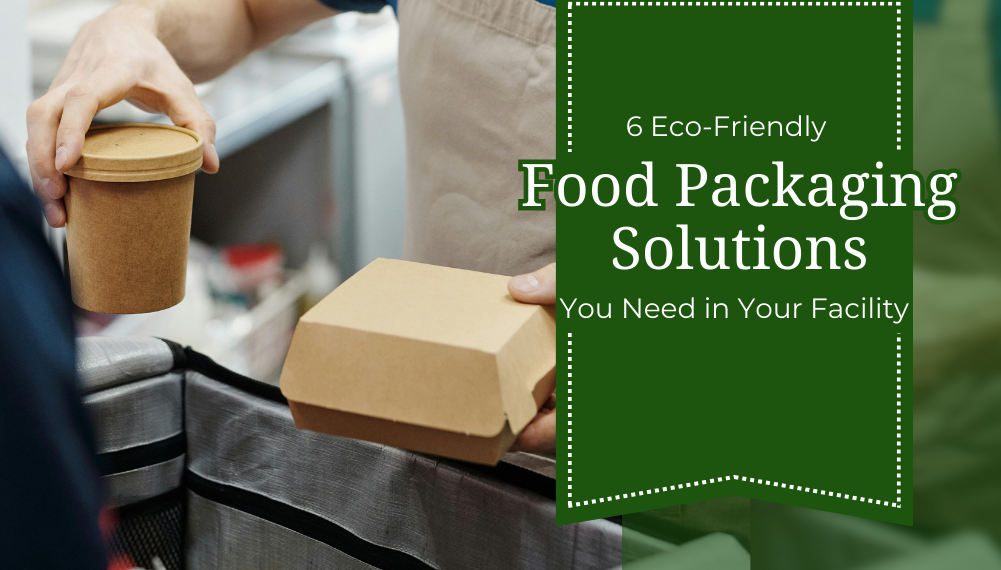Food and beverage is one of the industries that are committed to reducing the use of plastics. Manufacturers tend to look at customer demand when exploring solutions for eco-friendly food packaging. Despite businesses’ proactive steps, the demand doesn’t just begin and end with the retailer or consumer. Sustainable packaging solutions must begin within the supply chain production.
For food packaging, this means optimizing your production to incorporate sustainable solutions from beginning to end. Explore a variety of eco-friendly food packaging alternatives below for the ones which suit your business the most.
6 Sustainable Food Packaging Solutions for Your Business
Biodegradable plastic
Bioplastics are rising as a viable alternative for conventional plastics. These are derived from renewable materials like starch, cellulose, protein, bio-derived polyethylene, and aliphatic polyesters.
Though these plastics are made to biodegrade, this can only be achieved under certain conditions. Bioplastics still must be disposed of properly.
Reusable containers
Food manufacturers are swapping single-use meal take-out containers with reusable ones. These promote sustainability by reducing the need to purchase disposable utensils. On the consumers’ end, these containers can be washed and reused for food and liquid storage. Restaurants and retailers can benefit from investing in durable and long-lasting food grade containers.
Choosing the right manufacturer and machinery to source and create reusable containers is important to foster a more sustainable production facility. Elixir’s case packers ensure a seamless and eco-friendly process for the inspection, filling, and packing of beverages and other liquid products.
Plant-based food packaging
Plant-based food packaging is known for being organic, sourced from plants and durable raw materials. When these are broken down, they return to the environment bringing their derived minerals back into the cycle. Plant-based products exist for both primary and secondary packaging.
Popular examples include kraft paper, which is derived from virgin pulp fiber and is used in manufacturing linings for food packaging, especially those that have high exposure to grease and heat. Cellulose is a top choice for packaging films, paper, and cellophane. Bioplastics sourced from vegetable oil and fat, cornstarch, and other plant minerals are also plant-based.
Other plant byproducts include tummy-friendly solutions. Rice, seaweed, proteins, and starches are used to create eco-friendly, edible packaging.
Paper
Eliminating plastic use from packaging is challenging when it comes to transporting food and beverages, as well as other fragile materials. For delivery solutions, honeycomb paper is a known alternative for bubble wraps or foam. It is made from recycled paper pulp and is formed to resemble that of a honeycomb. The unique shape provides good cushioning for shipping and transport of dry goods and as linings for food and beverage.
Other paper products such as cardboard can also be derived from recyclable materials. Placing business labels and product specifications on paper packaging can be eco-friendly as well though using water or oil-based ink to print.
Glass
Materials suited for longer shelf life require more care. Glass is highly recyclable, and like food-grade plastics, it is safe for food storage.
Though it is sustainable, it can be quite expensive and consumes more energy, not to mention being heavier to store and transport. Despite this, glass is still widely used for product preservation and safekeeping. Glass bottles used for everyday beverages can be returned to the manufacturer, sanitized, refilled, and recapped for new products.
Aluminum
Beverage manufacturers should consider aluminum as an eco-friendly and sustainable packaging solution. It is considered the most sustainable as it can be melted and remolded into new products. Because recycled aluminum takes only about 5% of the energy required to create new aluminum, it is viewed as a more cost-efficient packaging.
The role of eco-friendly food packaging in advancing production
- Reduced production costs – Making the switch to sustainable food packaging may initially cost higher in the beginning. However, as the stages of production progress, this can minimize expenses for transportation and sourcing.
- Energy efficiency – Using packaging derived from renewable resources entails less use of energy, subsequently reducing greenhouse gas emissions throughout the supply chain process. Manufacturing paper products that are 100% recycled reduces carbon emissions by 38% compared to those produced from virgin pulp.
- Increased competitiveness and innovation – A more environmentally conscious manufacturing process gives your business leverage over companies that have not yet adopted sustainable food packaging. There are emerging opportunities to showcase innovations for sustainable packaging. Industry leaders continue to seek companies that develop new ideas and techniques for producing eco-friendly materials, which can contribute to a cleaner and greener economy.
Your business can contribute to a green economy by making proactive efforts to reduce ecological waste. By incorporating sustainable food packaging solutions, your business will attract more eco-conscious customers and partners.
ALSO READ: How to Adopt Sustainable Packaging Solutions for Your Business
Elixir carries trusted brands that guarantee seamless and eco-friendly solutions for your food and beverage packaging. Talk to us and make the switch to go green today.

